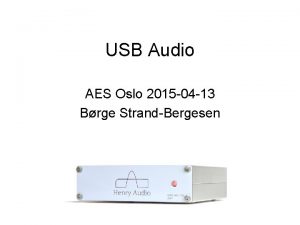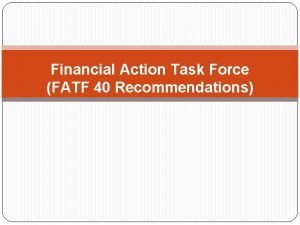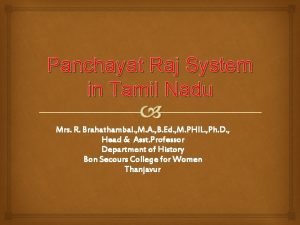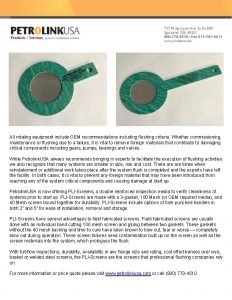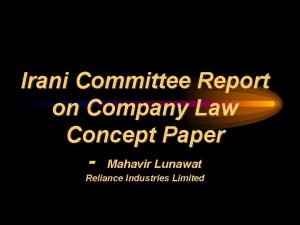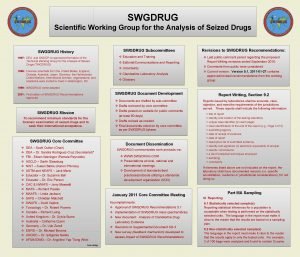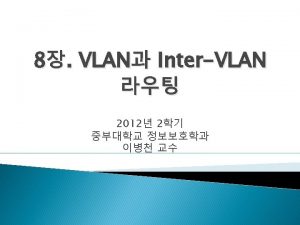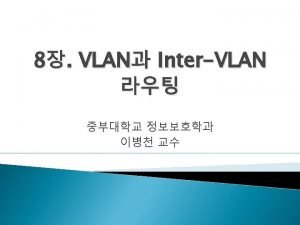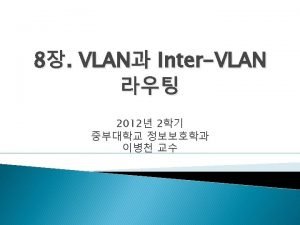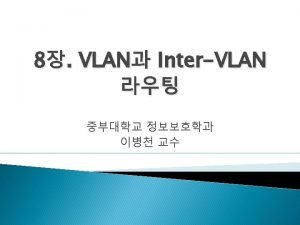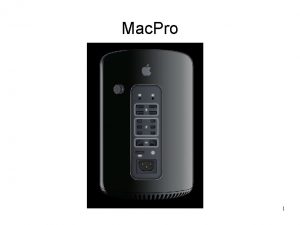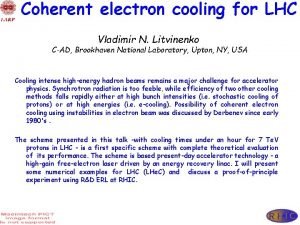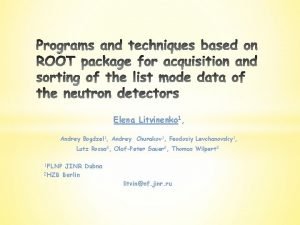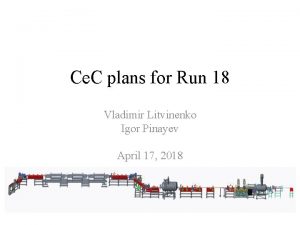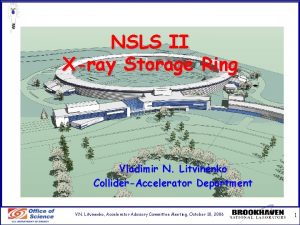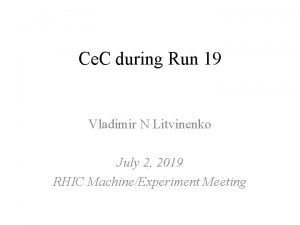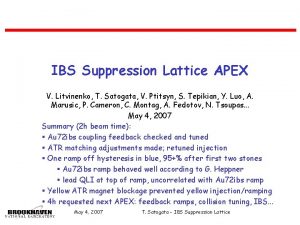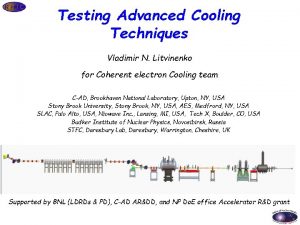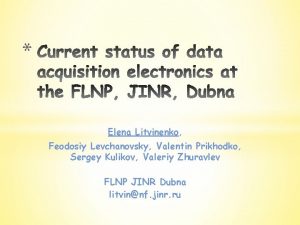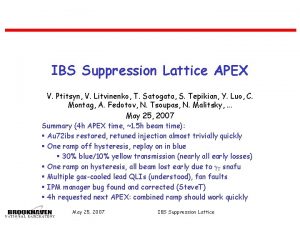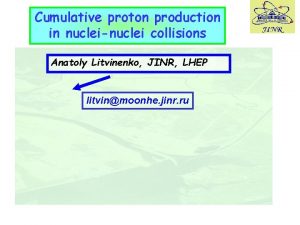Response to MAC 2014 recommendations V N Litvinenko



















- Slides: 19

Response to MAC 2014 recommendations V N Litvinenko

Recommendations • Carry out an overall review of the (somewhat complicated) theoretical design of the presently envisioned Ce. C-Po. P test with the help of external FEL experts to make sure it will work as planned and that nothing has been left out. – There was too many external and internal reviews and retreats to fit this one into already very busy schedule. C theory and simulations were one of the topics reviewed by e. RHIC R&D advisory committee in August 2014. We plan to have a dedicated review of the Ce. C theory in 2016. • Continue to carry out modeling studies of the cooling process with realistic ion bunch parameters in the time domain, including the IBS – We continued modeling of the processes with more realistic beam parameters including developing new computational tools - all in house. Unfortunately reduced (by 50%) level of funding did not allow to continue simulation efforts at Tech X. • Carry out cooling simulations with non-Gaussian electron bunches as seen and expected from the SRF gun – Unfortunately reduced (by 50%) level of funding did not allow to continue these simulation efforts at Tech X at full scale. Tech X made some progress, but we would need about $100 K of additional funds to make predictions for realistic beams. It will be combined with our own program to simulate the evolution of the ion bunch in presence of the Ce. C. • Determine the observables for the initial set of experiments. Define a minimum set of observations to declare success. – We defined the observables and minimum set of observations: (a) local cooling ; (b) longitudinal cooling of the entire bunch with intensity reduced to 1/6 of nominal • Initiate planning – We developed detailed plan and resource-loaded schedule.

Cooling full bunch Self-consistent simulations Preliminary © G. Wang Plot shows evolution of Au ion bunch profile after 40 mins of Ce. C using 1 n. C (10 psec long) and 3 n. C (30 psec long) electron bunches.

Schedule Construction Ce. C Po. P experiment is a DOE NP competitive R&D project – we are submitting quarterly progress and budget reports x - a milestone, X – major milestone Delivery of 704 MHz linac to BNL Assembling and tuning helical wigglers Installing/plumbing the 704 MHz in RHIC tunnel Install helical wigglers in RHIC tunnel CW laser is commissioned Beam diagnostics is intalled Optical diagnostics is installed Complete Ce. C beam-line ✓ 2/3 done x x x X 30 -Jul-15 1 -Oct-15 15 -Nov-15 01 -Dec-15 15 -Dec-15

Ce. C experiment is now a part of RHIC Run-16 plan

Schedule for RHIC run 16 (dates are tentative and are adjusted to the preliminary RHIC Run 16 schedule) Commissioning Milestones End date SRF cavities cold x 15 -Jan-16 Has to be synchronized with RHIC run Complete cavity conditioning X 20 -Feb-16 Generating first beam X 10 -Mar-16 Measuring beam parameters X 1 -Apr-16 Propagate beam to the beam dump x 20 -April-16 Test co-propagation with ion beam X 1 -May-16 Demonstrate FEL amplification X 15 -May-16 First cooling attempt X 02 -Jun-16 Dedicated 5 days of running

Schedule - demonstration (dates are tentative and will be adjusted to RHIC Run 17) Making necessary upgrades/improvements SRF cavities cold Complete cavity conditioning Recreating operational conditions Start Ce. C Po. P experiments (using APEX shifts) Demonstrate microbunching amplification (ACe. C) Demonstrate Ce. C Po. P cooling Ce. C cooling experiments end Improving and updating diagnostics, optical system, as well as installing buncher for 01 -Jul-16 31 -Dec-16 ACe. C test x 15 -Feb-17 Has to be synchronized with RHIC run X 01 -Mar-17 X 21 -Mar-17 X 07 -Apr-17 x X 30 -May-17 if time allows 30 -Jun-17 Dates have to be adjusted to the end of the 30 -Jun-17 RHIC run X

Resource Loaded Schedule Project Name Total FTEs Unburdened Material Cost (k$) Ce. C Experiment 23. 8 $1, 071

Ce. C Photo-injector • Adopt a robust cathode material with sufficient quantum efficiency – We use Cs. K 2 Sb in our SRF gun and generated up 1. 7 Me. V beam with 3 n. C per bunch charge – We built a “garage” to keep three cathodes, which can be inserted into the gun within one hour – Second garage is used for fresh cathode deposition and can replace the other in 2 weeks.

Ce. C: Overview of Construction Progress, Final Installation Planning • With respect to the available resources, the installation and commissioning of components for Ce. C Po. P may be in competition with the set-up of the LERe. C experiment. In order to avoid delays, an early prioritization should be made by the management for the case of conflicts – We developed detailed plan and resource-loaded schedule, which is compatible with LERe. C.

Ce. C: Theory/Simulations • Update the simulations of predicted cooling and diffusion in the Proof-of. Principle test and clarify the relation to experimental observables – We started the simulation, with a home-grown code, of the evolution of the ion bunches in Ce. C Po. P including diffusion from IBS and Ce. C. It will be used to further define the expected observables. • Since the Ce. C-Po. P will not test all aspects of the full Ce. C, specify clearly which essential physics and hardware aspects of Ce. C will be tested and which not – Ce. C Po. P will test all aspects of longitudinal cooling, including saturation and diffusion. What would not be tested is coupling of this cooling to transverse direction. Demonstrating the later would require both significant financial resources and significant RHIC modifications. Coupling (re-distribution) of longitudinal and transverse damping is a standard technique in electron/position storage rings. It used for redistribution of damping between longitudinal and transverse (horizontal) directions. Using the coupling of horizontal and vertical directions was successfully demonstrated in RHIC when a single plane stochastic cooler was cooling both horizontal and vertical oscillations. – Hence, we are considering demonstration of coupling and redistributing Ce. C cooling as an established technique and as a lower priority than demonstrating t novel and untested Ce. C

Ce. C: SRF and Warm RF Components • Push forward the commissioning of the SRF gun, monitor and report the progress. – We were very successful and in a last-ditch effort demonstrated operation of Ce. C SRF gun with Cs. K 2 Sb photocathode.

Conditioning 112 MHz Cavity Coherent electron Cooling Po. P

First beam from 112 MHz gun – June 2015 • • 1. 6 -1. 7 Me. V (kinetic energy) in CW mode Laser generated CW e-Beam with 3 n. C @ 5 k. Hz 2 Me. V in pulse mode 25 MV/m at photocathode Milestones reported to Do. E NP Q 3 FY 15 Demonstrating operation of 112 MHz SRF gun with 3 n. C charge per bunch, 1. 6 to 1. 7 Me. V kinetic energy in CW mode and above 2 Me. V in pulsed mode. Production of high QE photocathodes for 112 MHz SRF gun. Receiving helical wiggler system for Ce. C Po. P FEL amplifier Completion of the 704 MHz SRF linac cryo-module at Nio. Wave Inc. Completing the low energy transport beam line and its control system.

Ce. C: Diagnostics • Review the measurement of the small beam energy spread to make sure the needed resolution and ease of use are available at turn-on. – YAG screen and Gi. Gi camera resolution is sufficient for measuring the required energy spread • Review the measurement procedure of the absolute electron and hadron beam energies to make sure all known systematic errors at the 1 part in 1000 level are accounted for. – Absolute measurements of the energies are not required. Matching relativistic factors with 3 x 10 -4 accuracy should be sufficient for the task in hand. Electron beam energy can be monitored by BPM electronics at the required level in the dog-leg. We expect that RHIC energy is also reproducible with 3 x 10 -4 accuracy. This will be verified by our spontaneous radiation measurements (see 2 slides down) • Specify, measure and understand the various timing jitters among different RF, diagnostic and laser systems and the hadron bunch – We specified the requirements on jitter to be less than 100 ps between ion and electron beams and 0. 1 degree RF phase and laser pulse stability (at 112 MHz). These parameters are not yet demonstrated, but we expect that LLRF and laser system would meet this requirements.

Electron Beam and FEL Parameters for Ce. C Po. P experiment Electron Beam RMS Energy Spread ≤ 1× 10 -3 Normalized Emittance Peak Current ≤ 5 μm. rad 60 -100 A

Matching velocities/relativistic factors We rely on the increase of the short noise in electron beam induced by ion’s in the modulator Simulations parameters Electron beam: peak current 70 A 79 Au 197 beam: peak current 3. 37 A (γe-γAu)/γAu Plot shows the power of spontaneous radiation from Ce. C wigglers as function of the difference of relativistic factors between electrons as ions (γe-γAu)/γAu. When velocities are synchronized, ions induced additional short noise in the electron beam and increase the spontaneous emission more than 4 -fold.

Ce. C: e-gun Commissioning and Final System Commissioning Plan • No recommendations • You will see progress yourself tomorrow during the tour

Questions?
 Real banquo
Real banquo Mac mac o kok dac
Mac mac o kok dac Primary immune response and secondary immune response
Primary immune response and secondary immune response Natural and forced response
Natural and forced response First order system transfer function
First order system transfer function Fatf standards
Fatf standards Gvk rao committee recommendations
Gvk rao committee recommendations Swgdrug recommendations
Swgdrug recommendations Nap 6 recommendations
Nap 6 recommendations Oem recommendations
Oem recommendations Irani committee report
Irani committee report Omniture recommendations
Omniture recommendations Php best practices
Php best practices Towards deep conversational recommendations
Towards deep conversational recommendations Lamb to the slaughter critical essay
Lamb to the slaughter critical essay Jungalwalla committee
Jungalwalla committee Nap 6 summary
Nap 6 summary Making suggestions and recommendations
Making suggestions and recommendations Yashpal committee 1993
Yashpal committee 1993 Swgdrug
Swgdrug

